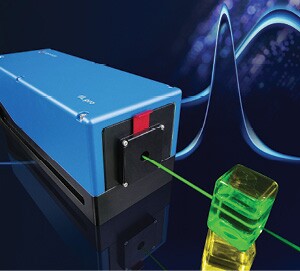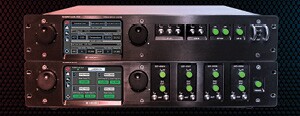Focus on lasers, imaging, microscopy, and photonics
DOI: 10.1063/pt.rpuy.zgvk
The descriptions of the new products listed in this section are based on information supplied to us by the manufacturers. Physics Today can assume no responsibility for their accuracy. For more information about a particular product, visit the website at the end of its description. Please send all new product submissions to ptpub@aip.org
Ultralow-outgassing Faraday isolator
Excelitas has launched its latest Linos ultralow outgassing Faraday isolator, which advances optical isolation technology and extends laser-system lifetimes by minimizing photocontamination. With a patented, glue-free design, the isolator outgasses less than previous low-outgassing versions and standard Faraday isolators, according to the company. Eliminating adhesive components reduces the risk of volatile organic contaminants degrading optical performance over time and ensures system cleanliness and reliability. According to the company, the Linos Faraday isolator delivers high performance with optimal isolation and high transmission, ensuring reliability and longevity even in demanding environments. It is suitable for high-vacuum environments, high-power laser applications, industrial solid-state systems, semiconductor manufacturing, and space applications. Excelitas Technologies Corp, 2545 Railroad St, Ste 300, Pittsburgh, PA 15222, www.excelitas.com

X-ray microscope
According to Bruker, its new X4 Poseidon 3D x‑ray microscope (XRM), a benchtop system that uses micro–computed tomography, offers advanced capabilities comparable to larger, floor-standing systems. It makes fast, high-resolution 3D x‑ray microscopy accessible for demanding XRM applications in materials science research and industry. Those areas include the geosciences, pharmaceutical R&D, composite materials, renewable energy, and microelectronics. It is also suitable for life sciences applications such as bone and dental research, soft-tissue imaging, and plant and animal biology. According to Bruker, the x‑ray source in the X4 Poseidon has a 3D resolution more than an order of magnitude higher than that of similar instruments. The system’s large field-of-view, high-efficiency detector can optionally be combined with a high-resolution scientific CMOS detector for multivision analytical flexibility. The X4 Poseidon is designed for low maintenance and is field upgradable. Bruker Corporation, 40 Manning Rd, Billerica, MA 01821, www.bruker.com

Ultrastable tunable diode laser
Toptica developed its DL pro BFY tunable diode laser for applications in which hands-off operation is required. It is equipped with temperature stabilization and can withstand pressure fluctuations and high winds. The hermetically sealed butterfly package and compact design of the resonator allow for the best passive-mode stability and robustness of all the lasers within the company’s DL pro family. Ultrastable against temperature and acoustic variations, the DL pro BFY features the DLC pro’s digital control for output precision and low noise. The DL pro lasers are reliable external-cavity diode lasers for operation at almost all wavelengths between 369 and 1770 nm. They offer power of up to 400 mW and a free-running linewidth down to 0.6 kHz. The graphical user interface makes remote access easy. Toptica Photonics Inc, 1120 Pittsford Victor Rd, Pittsford, NY 14534, www.toptica.com

Ultrastable frequency comb
Vescent Technologies has brought to market its RUBRIComb, a low-size, low-weight, and low-power optical frequency comb, and RUBRIColor, a companion wavelength extender that extends the RUBRIComb platform wavelength coverage from 490 to 2000 nm. They were developed to enable smooth, efficient experiments with high reliability, even in the field, in areas including atomic clocks and time transfer, quantum computing, and dual-comb spectroscopy. The RUBRIComb offers low-noise, turnkey operation and a long life. Having passed demanding shake, vibration, and thermal tests, the rugged laser is environmentally robust and sustains femtosecond-level stability, remaining locked for months with precise control. It also mode locks at every startup. Vescent’s unique oscillator design makes it easy to precisely factory match the repetition rate of several of its combs for multicomb-spectroscopy solutions. According to the company, its modular design and compact footprint make it adaptable and scalable to any quantum system. Vescent Technologies Inc, 14998 W 6th Ave, Ste 700, Golden, CO 80401, https://vescent.com

Image-scanning-microscopy analysis software
PicoQuant has released its NovaISM software for fluorescence-lifetime imaging microscopy (FLIM) and image scanning microscopy. The software is designed to advance FLIM by delivering superresolved spatial details and improved contrast. Seamlessly integrating with the company’s Luminosa confocal microscope, NovaISM is optimized for the company’s PDA-23 single-photon avalanche diode (SPAD) array detector. Key features for enhancing FLIM include pixel reassignment, which refines spatial resolution, and one-click deconvolution, which restores fine details and reduces noise. Those improvements ensure sharper optical sectioning, better signal quality, and image resolution up to 1.7 times as high as that of conventional confocal-microscopy images. State-of-the-art computational sectioning and lifetime species separation improve contrast and resolution. According to the company, with NovaISM, FLIM users can achieve a high level of clarity in cellular biophysics, protein interactions, and metabolic imaging. PicoQuant, Rudower Chaussee 29, 12489 Berlin, Germany, www.picoquant.com

Atomic force microscopes for large samples
Building on its Park FX200 model, Park Systems has enhanced its FX Large Sample atomic force microscope (AFM) series. The Park FX300 for 300 mm wafer analysis delivers advanced capabilities for R&D and quality control across a wide range of atomic force microscopy techniques. Specialized features include a sliding stage for long-range flatness measurements of copper pads in semiconductor postprocessing and an off-axis optics system for improved sample visualization. A fan filter unit ensures the AFM is contamination-free, making it suitable for use in clean rooms. The FX200 IR and FX300 IR models for nanoscale chemical analysis integrate Fourier transform IR spectroscopy with atomic force microscopy. They use photo-induced force microscopy to enable chemical identification with a spatial resolution of less than 5 nm. Users can analyze the chemical composition of nanoscale structures without damaging wafer surfaces. According to the company, that capability opens new possibilities for material characterization in semiconductor, polymer, and life sciences applications. Park Systems, 3040 Olcott St, Santa Clara, CA 95054, https://parksystems.com

Compact laser for flow cytometry
Hübner Photonics has unveiled the Cobolt Kizomba, a new addition to the Cobolt 05-01 laser series. The compact, robust laser offers 349 nm output at 50 mW and is designed for use in flow cytometry and other applications, including holography, interferometry, ion trapping, Raman spectroscopy, superresolution microscopy, and semiconductor inspection. The CW diode-pumped Cobolt 05-01 series lasers offer single-frequency operation, providing an ultranarrow linewidth of less than 1 MHz (greater than 100 m coherence length) and excellent spectral purity. The wavelength stability is less than 1 pm (over ±2 °C and 8 h) and the noise is low, at less than 0.1% rms. All Cobolt lasers are manufactured using HTCure technology for compact, hermetically sealed packaging, which ensures a high level of reliability and immunity to varying environmental conditions. Hübner Photonics Inc, 2635 N First St, Ste 202, San Jose, CA 95134, https://hubner-photonics.com

